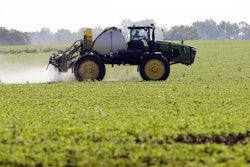FRESNO, Calif. (AP) — The school district in Turlock, surrounded by fields and orchards in one of the nation's richest agricultural regions, used to get much of the produce it served to students from national distributors who shipped fruits and vegetables from outside California.
But, starting in August, student meals have featured apples, peaches, nectarines, plums and oranges from farms only a few miles away — with the help of a new online company that connects local farmers with school districts.
California-based Ag Link allows school districts to communicate with nearby farmers and buy their produce with the click of a mouse. It's helping the Turlock district and others meet new federal rules requiring more fruits and vegetables in school cafeterias to help prevent childhood obesity.
"The quality and selection we're seeing coming right from the farms is incredible," said Scott Soiseth, director of child nutrition for the Turlock Unified School District. "Children get to eat the product that's picked that same morning."
The new rules require among other things that school provide students at least a half cup of either a fruit or vegetable during lunch and at least a half cup of fruit during breakfast. And they must be served a wider variety of fresh produce every week, including leafy greens and red-orange vegetables.
Online companies, cooperatives and organizations helping connect local farmers and buyers have cropped up in recent years. Now these so-called food hubs are facilitating relationships between farmers and school districts.
The Agriculture and Land-Based Training Association, a non-profit cooperative that trains new organic farmers in Salinas, Calif., is working with the Santa Cruz City Schools to coordinate orders and deliver produce. The district, with 13,000 students, purchases more than half of its produce from local farms.
In Vermont, a company called Green Mountain Farm Direct distributes a list of products, coordinates orders and delivers produce to half a dozen schools and other institutions.
And Oregon-based FoodHub, an online networking and marketing platform that connects food producers, buyers, and suppliers in Oregon, California, Washington, Alaska, Montana and Idaho, has been increasingly working with school districts looking to buy local, said director Amanda Oborne.
"School food directors are under water in figuring out what they have to do to keep up with the new federal guidelines," she said.
FoodHub currently works with 181 schools and districts, including some districts with as many as 80 schools.
"A lot of schools don't have contacts with farmers. They're a few miles away from each other and would never know they are so close. So having a directory and a networking tool at their fingertips is a huge help," Oborne said.
Ag Link, which also runs an e-commerce platform, was launched this month by a husband and wife team, Rob and Jana Nairn of Ballico in Merced County. Both have degrees in agri-business marketing.
A year ago, Jana Nairn and a school dietitian started consulting with school districts on how to improve menus and comply with the new regulations. The number one question schools asked was how to find sources of fresh, local produce. Ag Link provided an answer.
"There's all this produce here in our region, but we're still serving imported apples and bananas year round," Nairn said. "Why can't we tap into this bread-basket that's around us?"
Farmers post their products on the Ag Link site, school officials browse and make purchases. The company handles the billing and verifies farmers' certification and food safety standards. It charges a small transaction fee: 4 percent for farmers, 2.5 percent for schools. So far, about 15 school districts have registered, as well as about a dozen farmers.
The goal is to save school districts money and time, Nairn said, by cutting down on transportation costs, providing a list of farmers and an e-commerce platform.
"Schools don't have time to call around farmers and go shopping every week," Nairn said. "Our site allows that networking to happen online."
School officials say they must overcome hurdles when it comes to buying local. They must meet nutritional guidelines, follow safety standards, and get competitive bids from three producers. They also need to create procedures to chop, wash and store or freeze fresh produce.
But the extra effort is worth it for food managers like Soiseth in Turlock, where the district this year will double the amount of produce it buys to meet the new regulations. Ag Link already provides about 30 percent of the produce for the district's 9,000 students.
"It's revolutionary to our valley," Soiseth said. "Many of the new farmers we use are in our backyard, and we've been trying to reach out to them for a while, but we didn't know how."
And the price is right, Soiseth said: the district purchased Gala apples via Ag Link last week for 17 cents apiece, while through normal channels they would have cost 42 cents. The apples grow on a farm a dozen miles away.
Local farmers say Ag Link has helped them tap into a new market — the National School Lunch Program that serves 32 million children nationwide every day.
Noel La Rosa, who with her husband grows nectarines, peaches, cherries, plums, tomatoes, and watermelons on 40 acres in Hughson, Calif., has delivered cases of stone fruit to Turlock schools and is set to make a delivery to the Denair Unified School district this week.
"Our dream was to bring fresh fruit to schools," La Rosa said, "and this company showed up on our door to help make the connections."






















